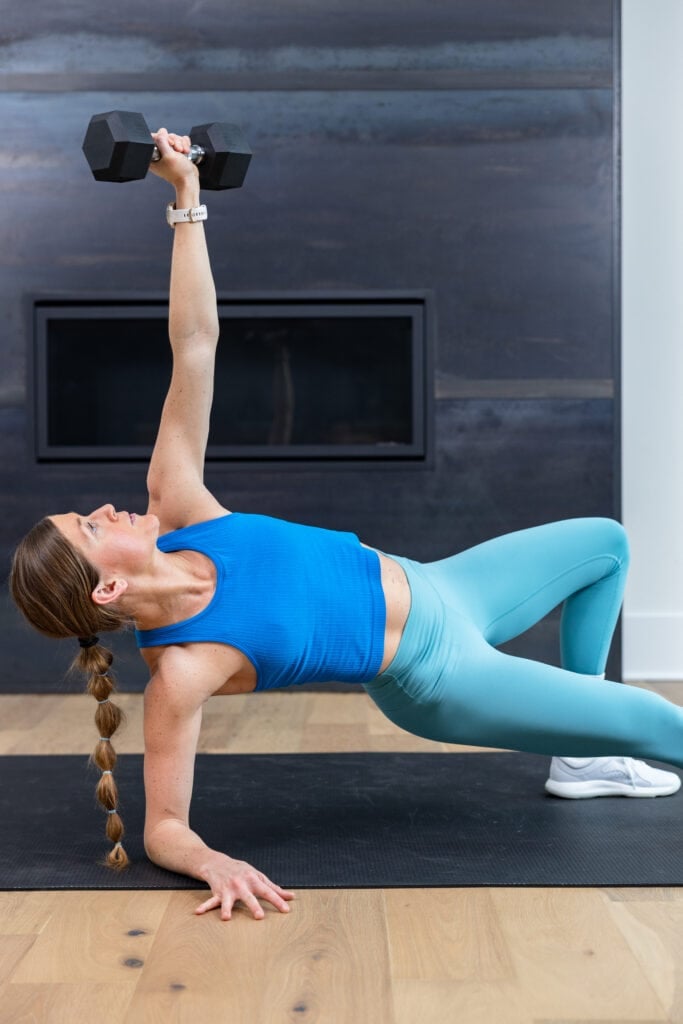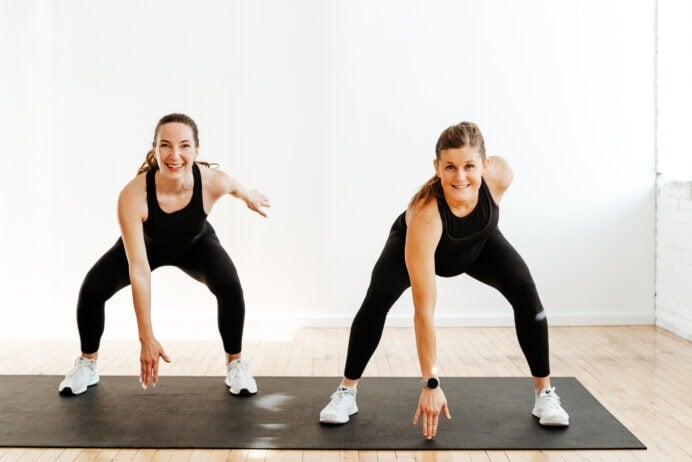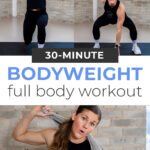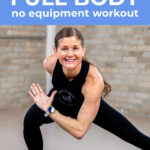
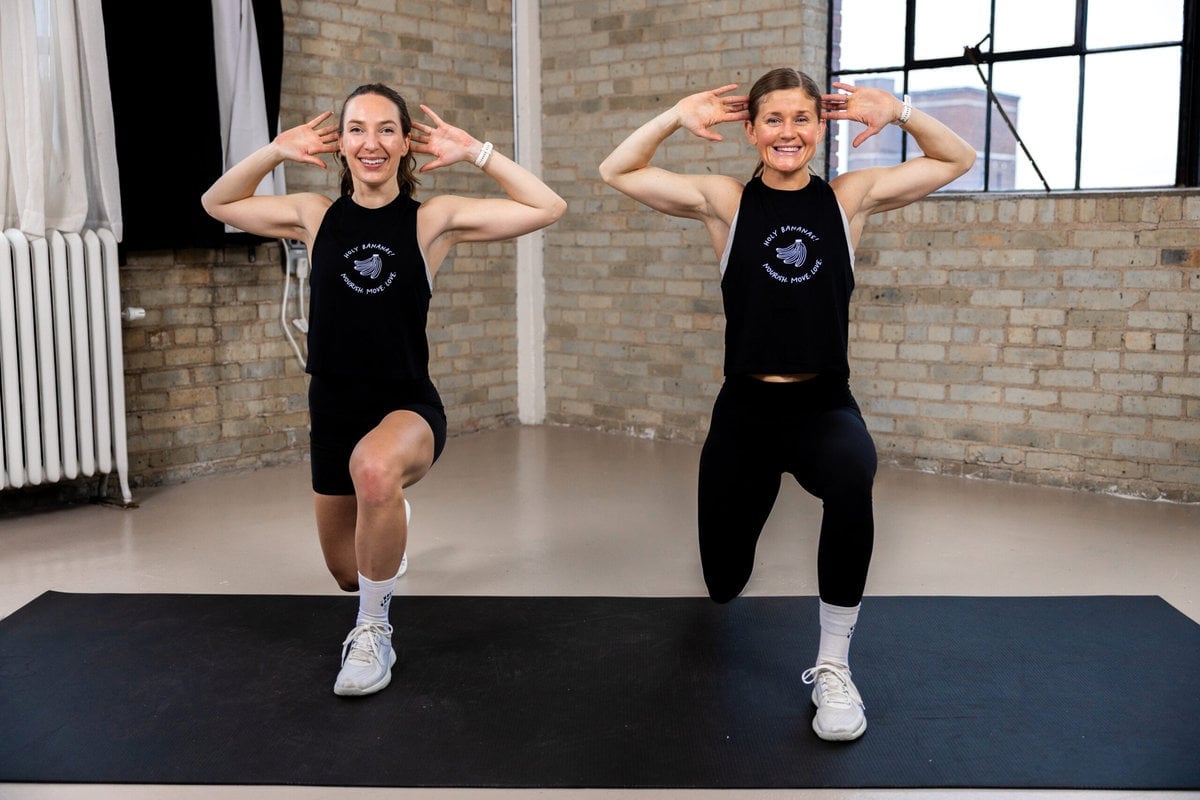
30-Minute Full Body Bodyweight Workout
Train anywhere with this effective full body bodyweight workout. The best bodyweight exercises to build muscle and tone the arms, legs, back, chest and core. We love that this workout can be scaled for all fitness levels. Each move includes options to make the exercise more advanced, or keep it low-impact and beginner-friendly.
Despite all the benefits, I still don’t think bodyweight workouts get the recognition they deserve.
Although I love training with heavy dumbbells, I think bodyweight workouts are a beneficial addition to any workout routine.
Bodyweight workouts are:
- Convenient. I find myself more likely to be consistent with workouts if I can train anywhere, anytime with just my own bodyweight.
- Functional. Bodyweight exercises are often functional, or mimic everyday movements (such as squatting, lunging, and pushing). Functional strength training makes it easier to perform daily tasks and reduce risk of injury.
- Challenging. One of the toughest programs I’ve filmed was our Zero30 Bodyweight Workout Plan. Bodyweight exercises can be surprisingly challenging.
Add these five best bodyweight exercises to your routine to build strength, increase athletic power and improve cardiovascular conditioning at home or on-the-go.

30-Minute Full Body Bodyweight Workout
Build total body strength anywhere with this 30-minute bodyweight workout.
A complete bodyweight workout targeting every muscle group in the body: the lower body (quads, hamstrings, glutes, calves, and thighs), upper body (biceps, triceps, back, shoulders, and chest) and core.
Add full body bodyweight workouts like this one to your bodyweight workout plan 1-2 times per week to build and maintain strength.
Workout Instructions:
Follow along with the guided Full Body Bodyweight Workout Routine on YouTube, led by certified personal trainer, Lindsey Bomgren.
Your Workout Looks Like This:
- 4 Circuits
- 3 Exercises Per Circuit
- Timed Intervals (perform each exercise for 30 seconds, then rest for 15 seconds. Move at your pace, performing as many reps of each move as possible within the work block.)
- Repeat Each Circuit x2 Sets
Workout Equipment:
No Equipment, Bodyweight Only.

Prefer to Watch On YouTube?
Workout Outline
CIRCUIT ONE:
- Pulse Squat and Squat Jack
- Push Up and Shoulder Tap
- Push Up Burpee and Squat Jack
CIRCUIT TWO:
- Pulse Lunge and Knee Drive
- Lunge Hold and Back Fly
- Lateral Lunge and High Knees
CIRCUIT THREE:
- Squat Pulse and Curtsy Lunge
- Plank Army Crawl and Cross Body Knee Drive
- Runner Squat
CIRCUIT FOUR:
- Single Leg Glute Bridge
- Tricep Dip and Reverse Plank Walk Out
- Hollow Rock Hold and Seated Twists
5 Best Bodyweight Exercises
Squat Pulse and Squat Jack
Targets: Legs, glutes, quadriceps, hamstrings, hip flexors, adductors (inner thighs), shoulders and core.

How To Do Squat Pulses and Squat Jacks
- Stand with your feet shoulder width apart or slightly wider.
- Inhale as you bend your knees and sit your hips back (as if sitting down in a chair). Aim for a 90 degree bend at each knee, focusing on pushing your knees out (not letting them cave in). Keep your torso in an upright position.
- Hold a low squat position, then pulse your hips up and down two to three inches, performing an additional half-squat.
- Exhale as you press through your heels to stand tall, driving your hips forward to return to standing position.
- As you stand, jump your feet in towards each other, pulling up through your inner thighs to bring your legs close together. Think about landing softly.
- Then, “jack” your feet out wide, bending your knees to perform another squat. Think, “feet wide at the bottom, narrow at the top”.
- Continue this pattern, alternating two squat pulses with two squat jacks.
Modification: Alternate tapping feet in for the squat jack rather than jumping.
Lunge Hold and Back Fly
Targets: Legs, glutes, quads, calves, inner thighs (adductors), outer thighs (abductors), posterior deltoids (rear shoulders), and back muscles (rhomboids and trapezius).
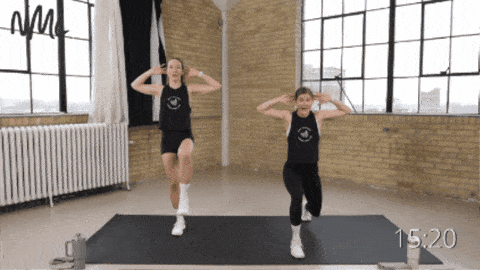
How To Do Lunge Holds and Back Flys
- Stand with your feet hip-width apart, knees slightly bent.
- Step your right foot back and lower your back right knee down towards the mat into a reverse lunge. Aiming for a 90-degree bends in both knees. Hold this low lunge position.
- Then, lightly place your fingertips behind your head, elbows at shoulder level, pointing towards the front of the room.
- Squeeze your shoulder blades together as you open your elbows wide, performing a bodyweight back fly.
- Slowly and with control, reverse the movement, bringing your elbows in front of your shoulders and returning to starting position.
Modification: Rather than a lunge hold, perform a back fly from a standing position. Option to balance on one foot for an additional core challenge.
Plank Army Crawl and Cross Body Knee Drive
Targets: Arms, shoulders, chest, triceps, back, legs, glutes, quads, abs, obliques and core.
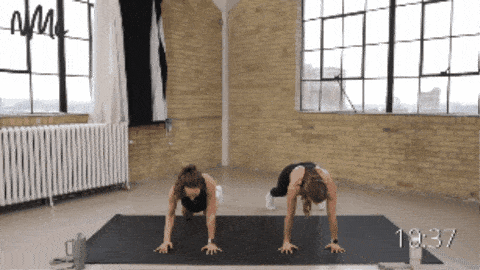
How To Do Plank Army Crawls and Cross Body Knee Drives
- Start in a high plank position with your shoulders stacked over your wrists, weight evenly distributed amongst all ten fingers. Hold this high plank position, maintaining a straight line with your body, gaze slightly in front of you.
- Then perform two crossbody knee drives — pulling right knee towards left elbow, then left knee towards right elbow.
- Drop first your left forearm to the mat, then your right forearm to the mat, finding a low plank or forearm plank position. Shoulders are stacked over elbows.
- Exhale as you push yourself back up to the starting high plank position; starting with your left arm and following with your right arm. Try to keep your hips stable and even.
Modification: Perform a rolling plank rather than the cross-body knee drives.
Single Leg Glute Bridge
Targets: Glutes, hamstrings, hips and pelvic floor.

How To Do Single Leg Glute Bridges
- Start laying on your back, knees bent and feet planted on the floor. Feet are hip width apart. Float your left foot off the ground.
- Press through your right heel to lift your glutes off the mat, squeezing your glutes as you lift. Think about keeping your core engaged and knees in line with your hips.
- Slowly and with control, lower your hips, hovering just off the mat and returning to starting position.
Modification: Perform a standard glute bridge with both feet planted on the ground.
Tricep Dip and Reverse Plank Walkout
Targets: Legs, glutes, hamstrings, hips, calves, low back, shoulders, abs and core.

How To Do Tricep Dips and Reverse Plank Walkouts
- Start seated on the ground, knees bent at 90 degrees and heels within reaching distance of your fingertips. Plant your hands on the ground, fingertips pointed towards your glutes.
- Press evenly through your palms and heels to lift your hips off the floor.
- Perform a tricep dip by slightly bending the elbows, lowering your hips two to three inches without touching them to the mat.
- Squeeze through the back of your arms to straighten your elbows, then repeat, performing two tricep dips.
- Then, keep elbows straightened (shoulders stacked over wrists) and hips lifted as you walk your feet away from your body, finding a reverse plank position.
- Hold this reverse plank, then perform two alternating knee drives, pulling first your left knee in towards your chest, then your right knee.
- Then, step your feet in, returning to starting position.
Modification: Omit the knee drives, holding a reverse plank instead.
Full Body Bodyweight Workout FAQs
Bodyweight moves are an accessible way to get in shape anywhere. Bodyweight training is especially effective for beginners, as it builds the mind-muscle connection, supports fuller range of motion, and teaches proper form before adding load.
Yes, bodyweight exercises are extremely effective at burning fat. Both beginner bodyweight cardio exercises and advanced bodyweight HIIT exercises are known for raising the heart rate, burning calories and increasing metabolism, which leads to fat burn.
Full body workouts are excellent for building overall strength and fitness, especially for beginners. As you advance, I recommend following a split training program to truly fatigue each muscle group with more focused workouts.
More Workouts
Bodyweight WorkoutsPin This Workout: Full Body Bodyweight Workout

This post includes affiliate links. I do earn a commission for products purchased using these links (at no additional cost to you). Thank you for supporting Nourish Move Love, making the content you see on this blog possible.










